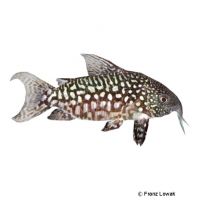Gery's Cory (Corydoras geryi)
| Gery's Cory Corydoras geryi | |
|---|---|
| Name | Gery's Cory |
| Name Lat. | Corydoras geryi |
| Synonym | Corydoras bolivianus |
| Family | Armoured Catfishes |
| Family lat. | Callichthyidae |
| Order | Catfishes |
| Order lat. | Siluriformes |
| Origin | Bolivia |
| Habitat | Streams, ponds |
| Diet | Omnivore |
| pH | 6.0-7.5 |
| Behavior | Peaceful |
| Keeping | Group |
| Care Level | Moderate |
| Reproduction | Substrate spawner |
| Breeding | Difficult |
| Life Span | 4-8 years |
| Protection | No |
| Metric Units | |
| Size | 6-7 cm |
| Temperature | 22-26 °C |
| Hardness | 2-15 °dH |
| Aquarium | ~ 120 l |
| US Units | |
| Size | 2.4"-2.8" |
| Temperature | 72-79 °F |
| Hardness | 36-267 ppm |
| Aquarium | ~ 30 gal |
Distribution and habitat
The distribution area of Gerys Cory's Catfish is the inlet of the Rio Mamore in northwestern Brazil and Bolivia. They live there in shallow, slow-flowing and stagnant waters with sandy bottoms covered with dead wood, branches and fallen leaves.
Maintenance
The aquarium should have dense planting with shady hiding places (roots, large river pebbles). In order not to injure their barbels (serve for orientation and foraging), a soft, sandy substrate is ideal, which should be covered with some mulm and foliage (e.g. sea almond leaves).
Shaded light (floating plants) and soft, slightly acidic water is ideal
No ammonia, ammonium and nitrite should be detectable, the nitrate value should not exceed 100 mg/l. To ensure the water quality and oxygen content, a filter and heater adapted to the aquarium size is required, as well as lighting for the species-appropriate day-night rhythm of the animals.
Diet
The food supply consists of live, frozen and dry food. For a balanced diet, feed once a day with a high-quality sinking dry food for catfish (granules, pellets, chips, tablets) as well as cyclops, daphnia, artemia, mysis, tubifex or mosquito larvae (live or frozen). In addition, occasionally some vegetable food, such as algae leaves or dry food with vegetable components (e.g. spirulina, kelp).
Only feed as much as is eaten within a few minutes. A regular and varied diet promotes health and increases resistance.
Behaviour and compatibility
They are peaceful and sociable fish that live in groups. At least 4-6 animals should be kept together. They are well suited for a community tank with other peaceful, not too big fish
Basically, only compatible fish species with similar requirements for water conditions and water temperature should be socialized.
Sex dimorphism
The sexes are difficult to distinguish. Females are slightly larger, more high-backed, and more plump when viewed from above. During the mating season the males show an attractive net pattern.
Reproduction and breeding
There are isolated reports of successful offspring. A breeding group consists of 2-3 males and one female. During mating (T-position), the eggs (1-4) enter a pocket formed by the ventral fins of the female and are attached to substrates (e.g. leaves, stems) after fertilization. The larvae hatch after about 3-4 days and swim freely after 2-5 days.
Fry must be fed several times a day with special rearing food (Artemia nauplii). In a community tank breeding is hardly possible, because the spawn is easy prey.
Important
They have additional intestinal respiration to survive in oxygen-poor waters and sometimes come up to the water surface for air even in the oxygen-rich aquarium.
The foliage (sea almond tree, oak, etc.) enriches the water with humic substances, naturally lowers the pH and is a valuable secondary food source.
When fishing, use the finest mesh nets possible to avoid snagging the hard rays of the pectoral fins, which can cause painful puncture wounds when touched
The well-being of the fish should be checked regularly. Temperature should be checked daily, pH, hardness and nitrate levels at least every 14 days. Regular partial water changes are recommended, even when contaminant levels have not yet reached the upper limit. Sudden changes in water quality should be avoided. Newly introduced fish must be accustomed slowly to the water in the aquarium.
Further literature can be found in your pet store.
References
Text: petdata; Image: Franz Lowak
Source: BMELV (1998): Tierschutzgutachten - Haltung von Zierfischen (Süßwasser); BAENSCH & RIEHL (2004): Aquarien Atlas Bd. 4, Mergus Verlag; ENGELMANN (2005): Zootierhaltung - Tiere in menschlicher Obhut: Fische, Verlag Harri Deutsch
- Gemäß § 21 Abs. 5 Tierschutzgesetz idgF
